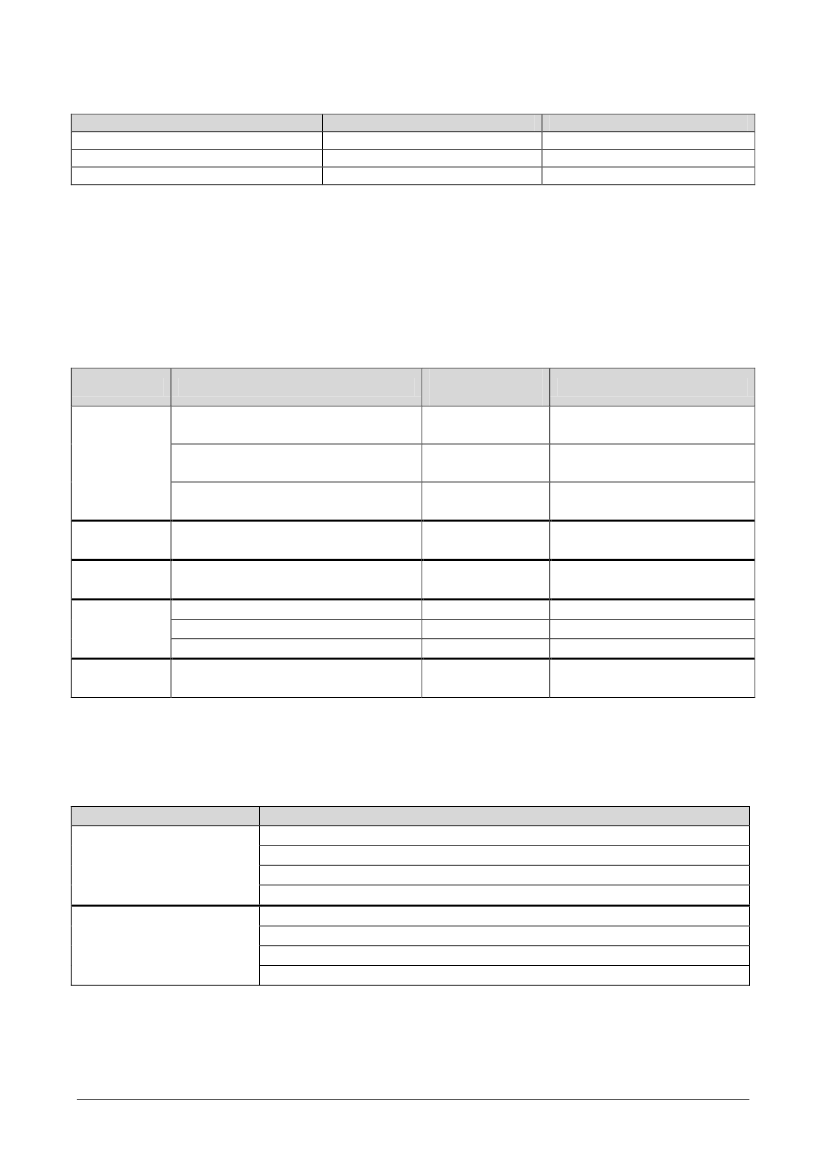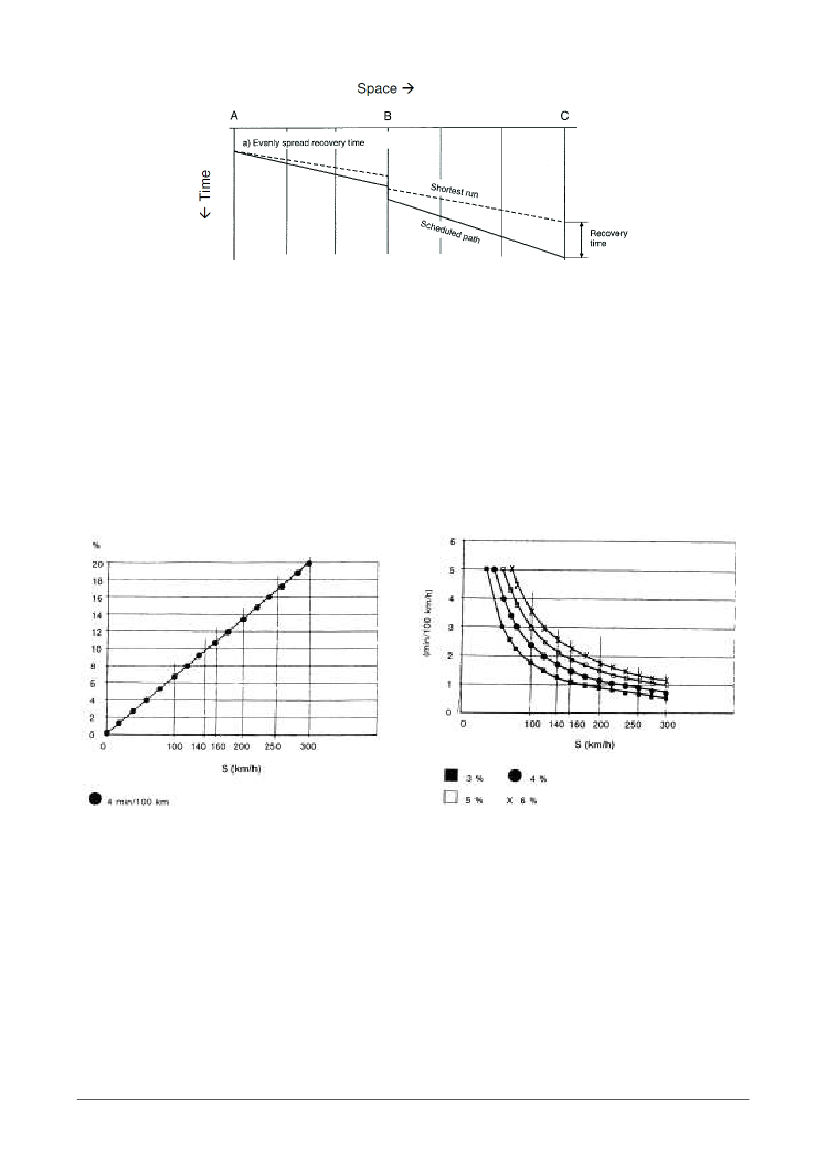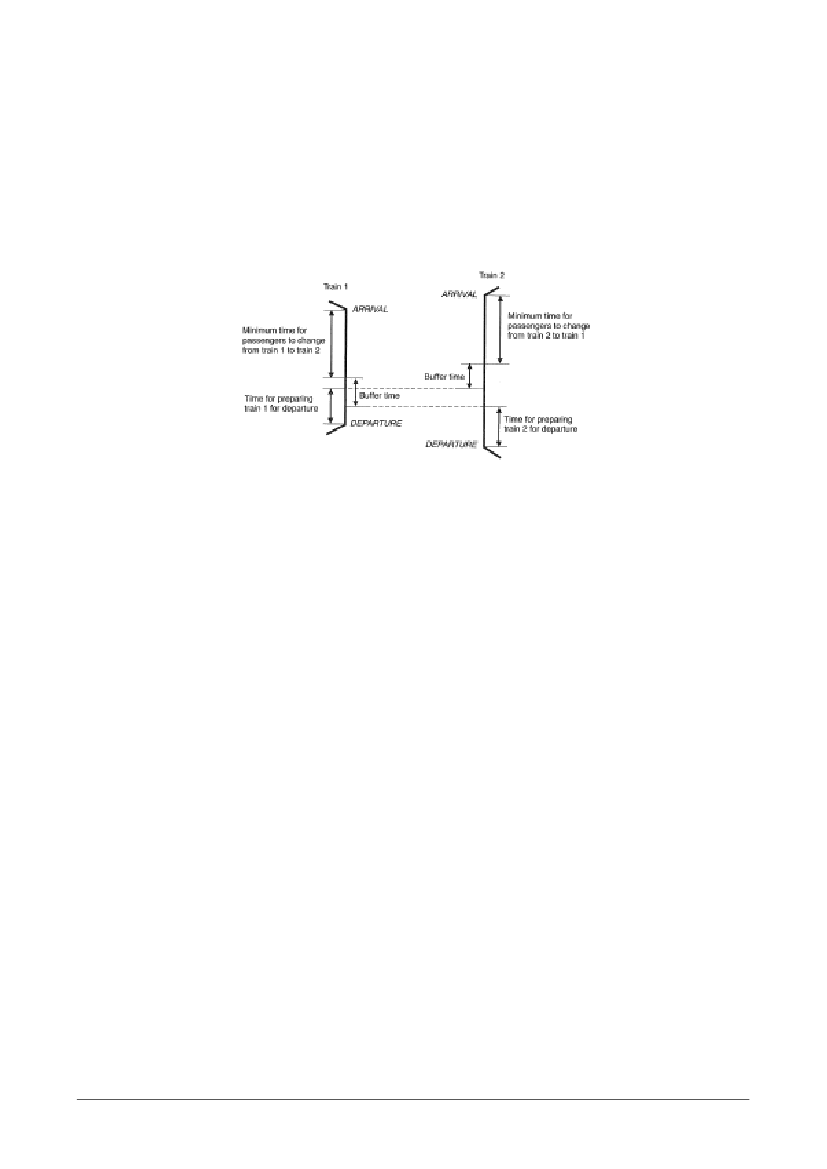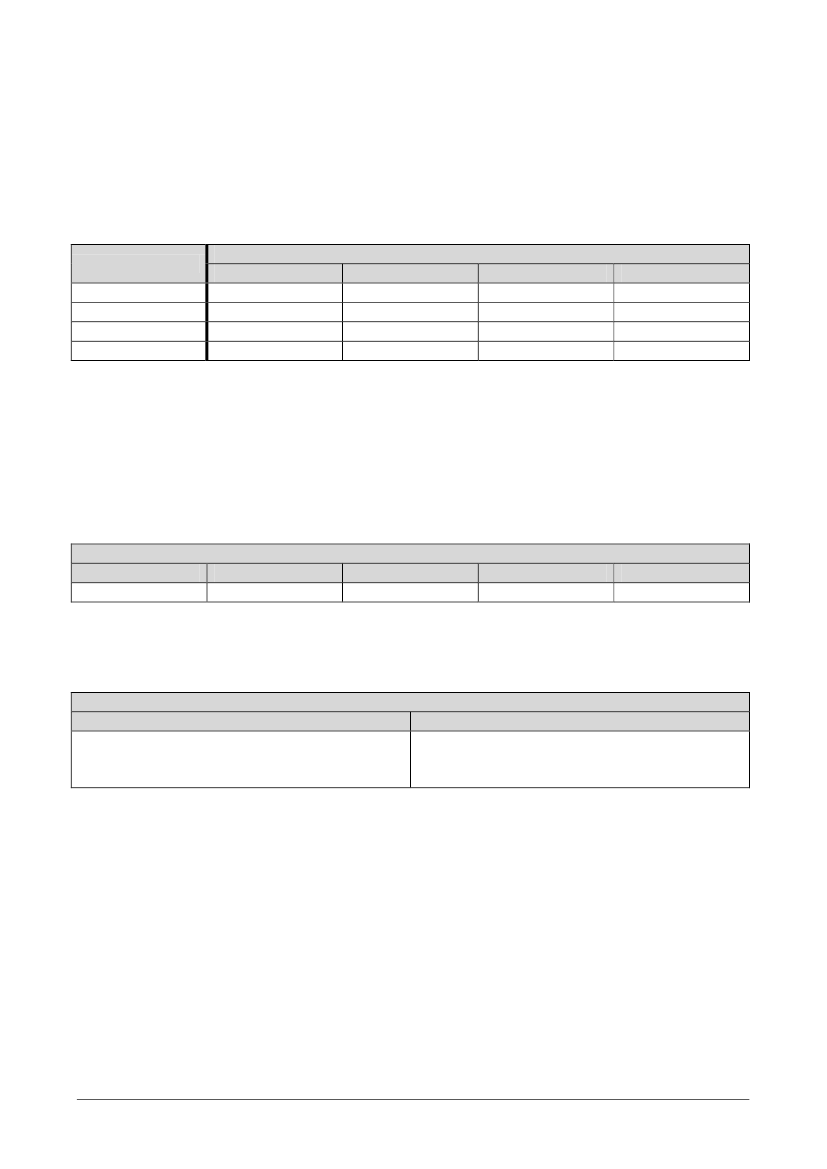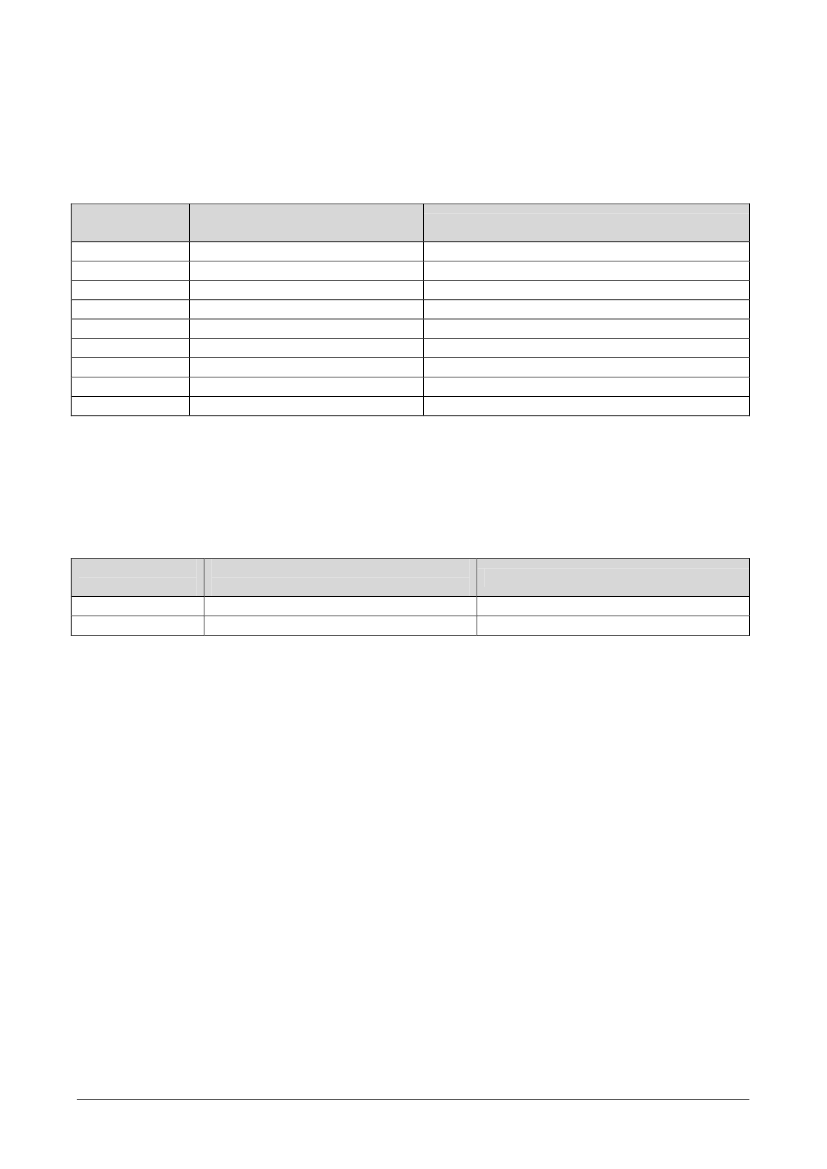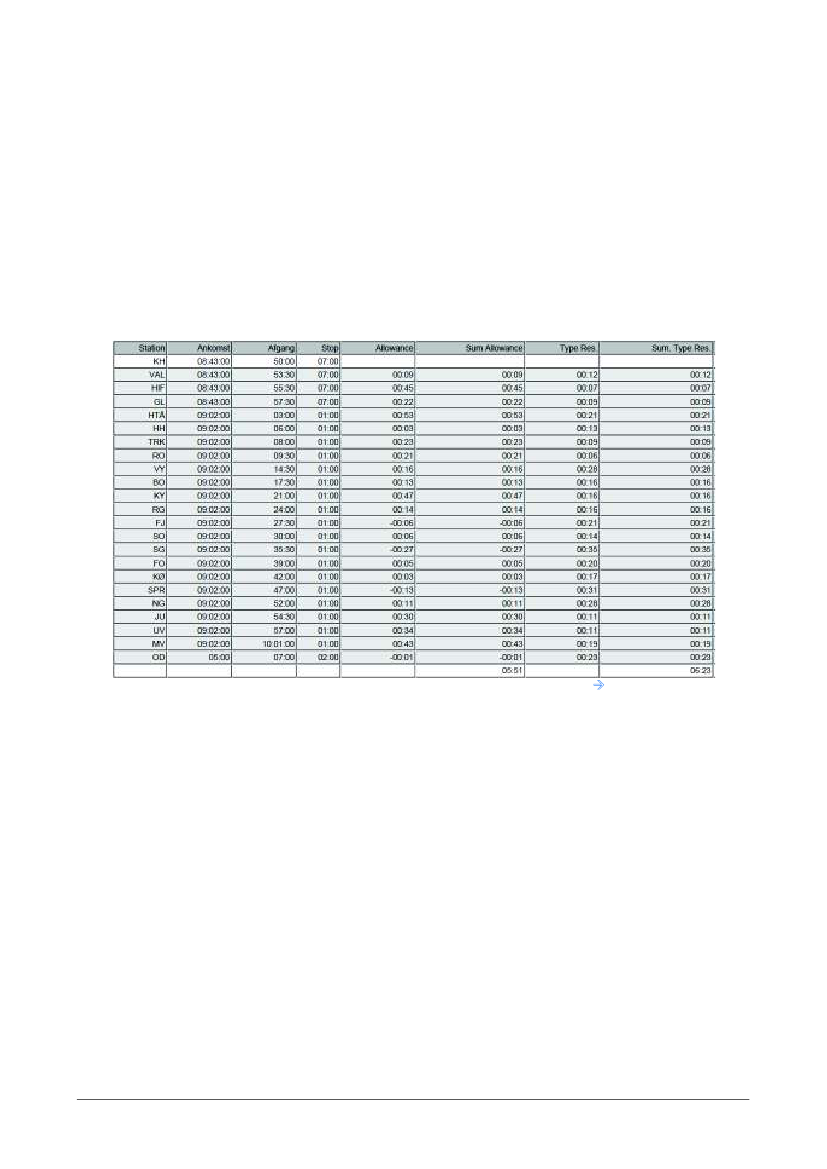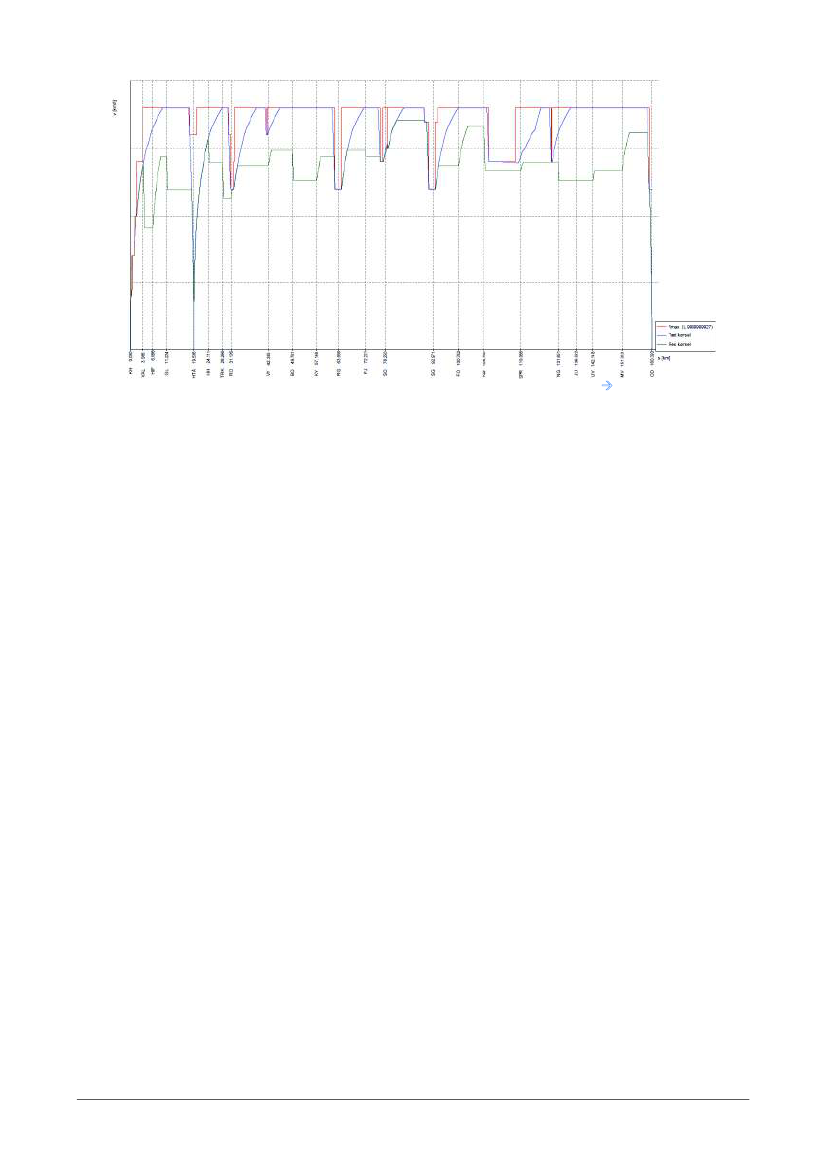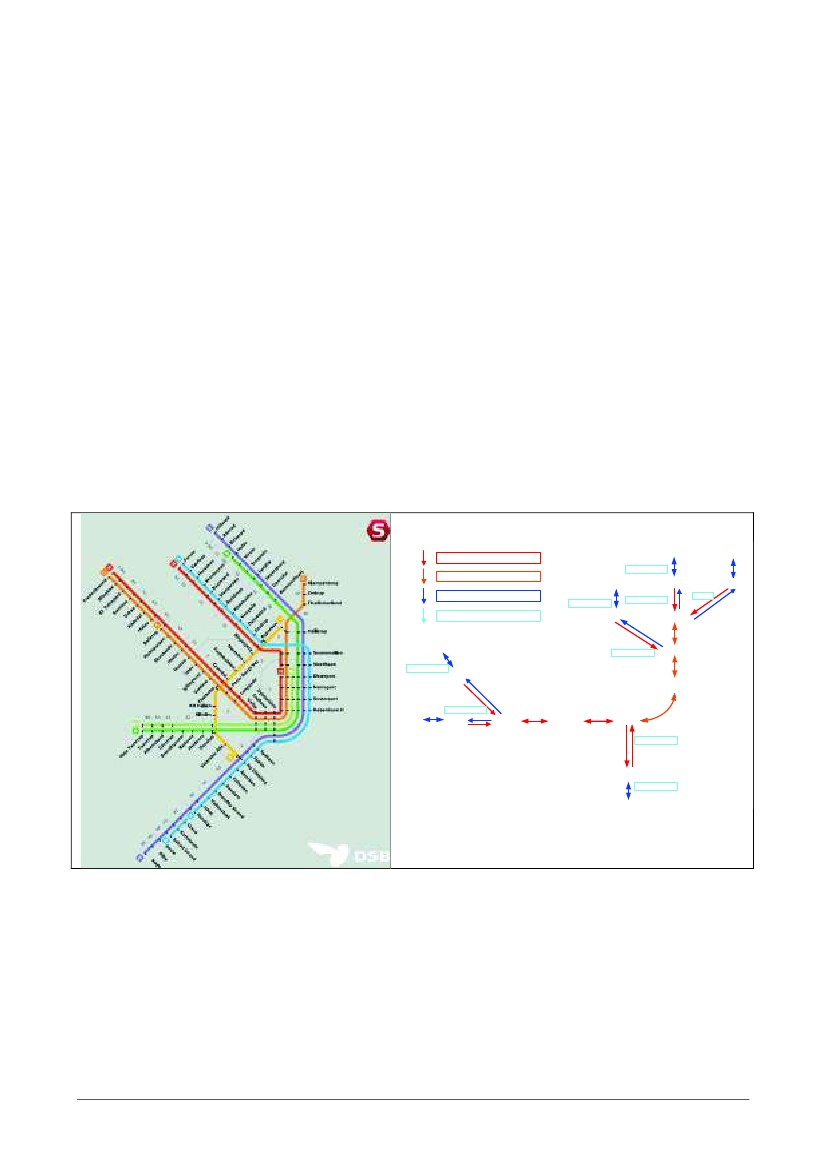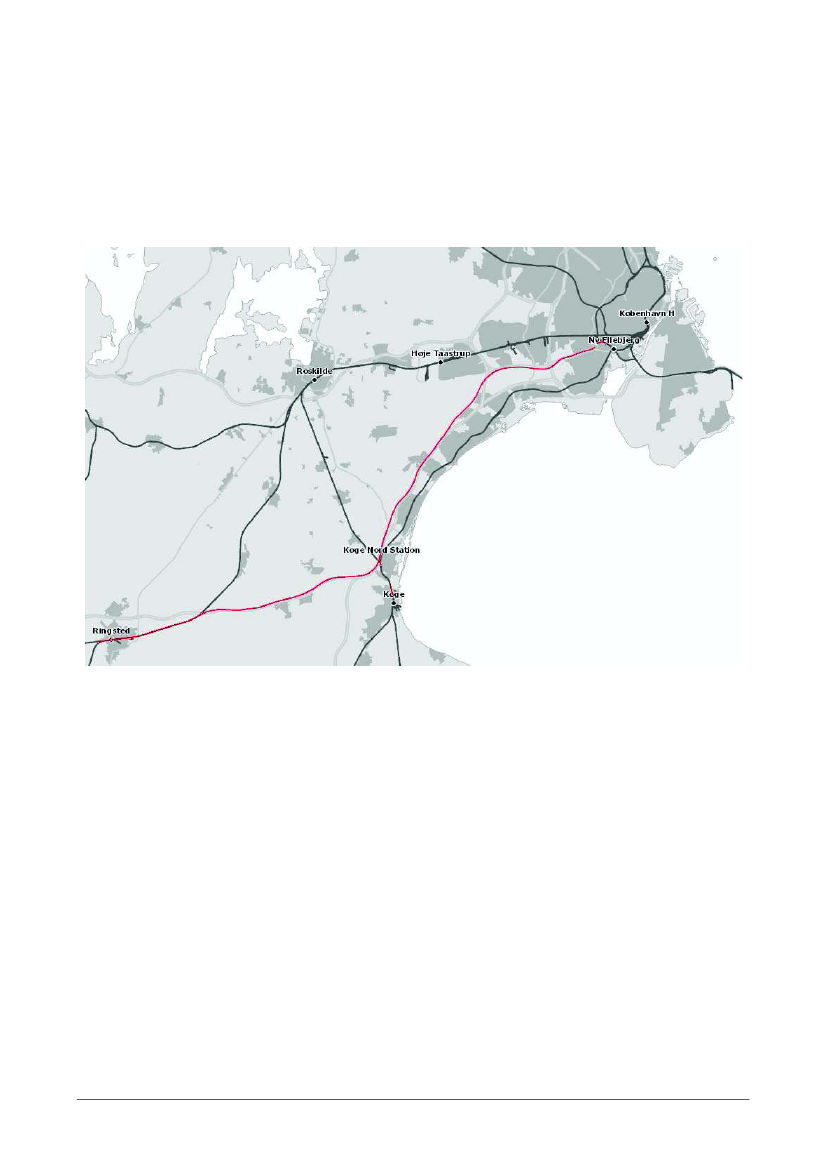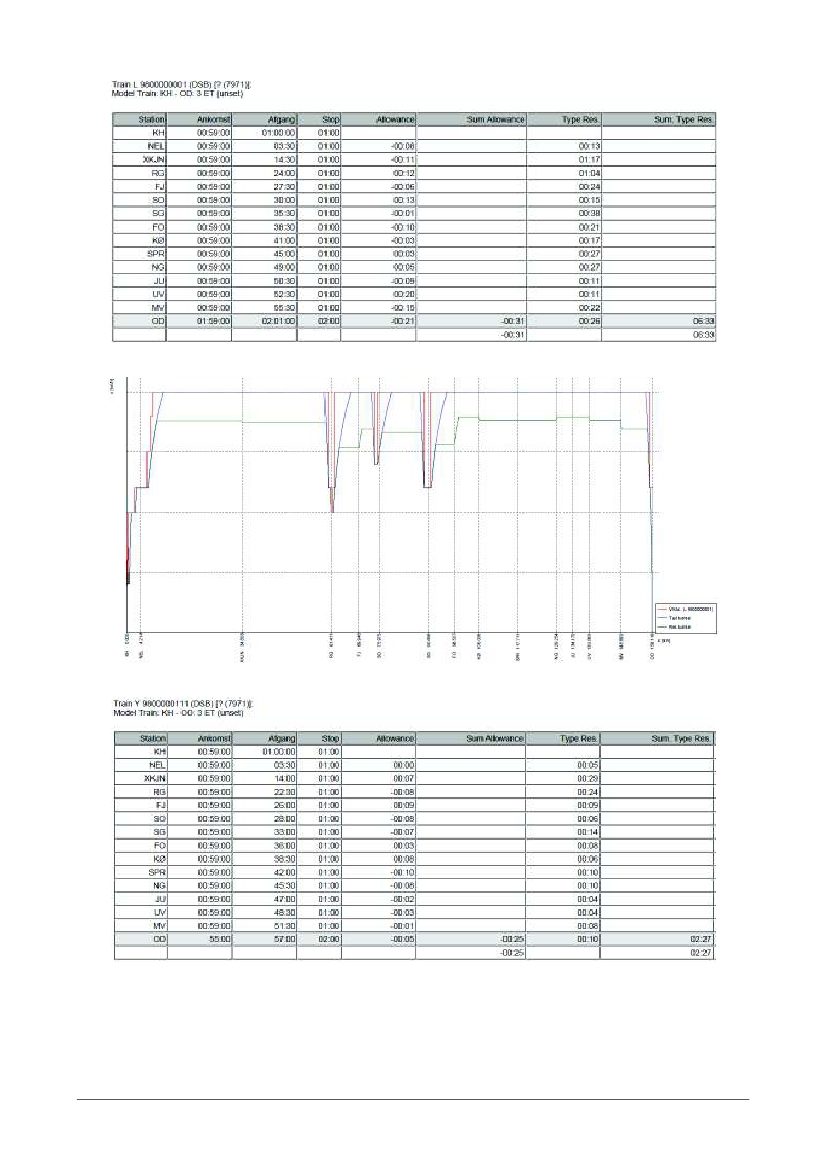Transportudvalget 2012-13
TRU Alm.del
Offentligt
Denne artikel er publiceret i det elektroniske tidsskriftArtikler fra Trafikdage på Aalborg Universitet(Proceedings from the Annual Transport Conferenceat Aalborg University)ISSN 1603-9696www.trafikdage.dk/artikelarkiv
Planning With Timetable Supplementsin Railway TimetablesBernd Schittenhelm,[email protected]& [email protected]DTU Transport – Department for transport & Rail Net Denmark
AbstractThe use of time supplements in railway timetables is a trade of between attractive travel times andpunctuality levels. Punctuality is a key performance indicator for timetables and time supplements aretherefore applied in any timetable. Time supplements can be found as running time supplements, dwelltime supplements and buffer times between trains. These are described in the paper.Through analyzing the present valid timetable it is shown that the present size of running time supplementsis approximately 50% bigger as recommended by the UIC. Unreliable input data for the timetabling processcan be a valid reason for unnecessary high time supplement levels in the timetable.Making the best use of the applied running time supplement has resulted in several application strategies.Several are presented in the paper. A Danish success story is the use of condensation and compensationzones on the Copenhagen suburban railway network. This is inspired by the approach used in the SwissBahn2000 timetable for station hubs.A political demand for future travel times not higher than or below one hour between the cities ofCopenhagen and Odense leads to an investigation of 3 possible scenarios: Applying the existing planningrules in regards to time supplements, using the recommendations from the UIC or making a compromise byadapting the existing rules to fulfill the political demands. It is shown that the existing planning rules cannotprovide the necessary reduction in travel time. Critical low levels of running time supplements are theresult when using UIC recommendations. A compromise can be the solution. This demands a halving of thepresently applied running time supplements and therefore also a new approach to timetabling and railwayoperation in Denmark.
1 IntroductionPunctuality is one of the key performance indicators (KPI) in public transportation and thereby also for thepublic railway system. This applies to both passenger and freight traffic. Reliable and punctual trains makepassenger trains more attractive towards potential customers and just-in-time delivery for productioncompanies has become more usual within the freight transportation business.
Trafikdage på Aalborg Universitet 2011
ISSN 1603-9696
1
Table 1: Overview of train delay thresholds in Denmark [13]
Train categoryLong distance passenger trainCopenhagen suburban train (S-tog)Freight train
Delay threshold [min:sec]05:0002:3010:00
Punctuality target [%]959085
Table 1 shows the thresholds for different train categories as being delayed and the political decidedpunctuality targets for trains in Denmark.In Denmark the threshold for long distance passenger train being registered as delayed is 05:00minutes atany station or location where trains are being registered either automatically or manually. The punctualitytarget for long distance passenger trains is that 95% of all trains are running on time. In other countries thedelay threshold can be different as can the delay measuring approach. Table 2 gives an overview ofselected European countries [4].Table 2: Overview of delay thresholds for train categories in different countries [4].
Country
Train categoryLong distance + regional passengertrains
Delay threshold[min:sec]05:0002:3010:00
Measuring approachEntire train run. Arrival anddeparture.Entire train run. Arrival anddeparture.Entire train run. Arrival anddeparture.Selected larger stations.Arrival.Selected larger stations atarrival and at signal boxes.Selected stations. Arrival.Selected stations. Arrival.
Denmark
Copenhagen suburban trainsFreight trains
Long distance + regional passenger03:00trainsLong distance + regional passenger05:00SwitzerlandtrainsLong distance passenger trains05:00GermanySuburban trains (S-Bahn)02:00Freight trains30:00Long distance + regional passenger15:00End of line. Arrival.ItalytrainsTrains get delayed because they are subject to stochastic happening incidents that cause train delays.These incidents can be categorized into two groups [2]: Incidents that have the potential to create highlevels of train delays and incidents that create low levels of train delays. Table 3 gives an overview ofexamples for these incidents.HollandTable 3: Stochastic incidents that can cause train delays [5]
ExamplesInfrastructure failure: Track, switch, interlocking, communicationPassenger: Very extended dwell times, collision, suicideHigh level of train delaysRolling stock: Break down, very reduced tractionOutside: Bad weather, action by third partInfrastructure: Reduced speed on sectionPassengers: Extended dwell timeLow level of train delaysRolling stock: Reduced traction, single door failureOutside: Poor weatherThe prepared yearly timetable for a railway system is a static document where changes are made onlyrarely during the validity period. This makes it necessary to implement time reserves - called timesupplements - in the railway timetable in form of running time supplements, dwell time supplements andbuffer times between trains. By doing so it becomes possible to avoid or minimize stochastic happening
Incident category
Trafikdage på Aalborg Universitet 2011
ISSN 1603-9696
2
train delays of a certain magnitude [2]. If the consequences of the delay causing incident are to big the useof time supplements will not prevent trains from getting delayed, terminated short or even cancelled – seehigh level of train delays in Table 3. Time supplements can ensure that a delayed train is able to catch upwith the timetable if the delays can be kept within a reasonable scale – see low level of train delays in Table3.In a liberalized railway market, such as the Danish, the railway sector is divided into infrastructuremanagers (IMs), train operating companies (TOCs) and the railway authorities. Interested TOCs apply forthe use of capacity – timetable train paths - with the relevant IM who then prepares the timetable trying toaccommodate as many wishes from the TOCs as possible. Each IM has a set of planning rules according towhich the timetable is prepared. These planning rules include the use of time supplements [3].In section 2 a set of definitions in regards to train running times and time supplements are presented.These are followed by recommendations for the use of time supplements in railway timetables by theinternational association of railways – the UIC - in section 3. The planning rules in regards to timesupplements applied by infrastructure manger Rail Net Denmark are described in section 4 and a practicalexample from the present valid timetable is given. In section 5, two recent strategies for placement of timesupplements in railway timetables are presented. This is followed by two Danish cases in section 6: Thepresent timetable for the Copenhagen suburban railways (S-tog) and the future “One hour model” betweenthe cities of Copenhagen and Odense. Finally conclusions are made in section 7.
2 DefinitionsScheduled running times of trains in timetables consist of the following four contributions [2][10]:1.The minimum running time between locations– this depends on the driving characteristics of therolling stock - e.g. acceleration, maximum speed and breaking capabilities, driving style of the trainengineer – and the characteristics of the infrastructure – e.g. interlocking system, traction currentpower supply and maximum allowed line speed.2.Dwell times at stops– stops are normally put into categories according to the number ofpassengers embarking and/or disembarking trains – e.g. little, medium or large number ofpassengers. Dwell times are based on empirical data e.g. simple timing of train stops.3.Time supplements– running time supplements, dwell time supplements and buffer times betweentrains. These are described in detail in the following sections.4.Scheduled waiting time– To be able to create a feasible timetable it can become necessary toincrease the scheduled running times of trains. Reasons for this can be synchronization of differenttrain services at an interchange station, synchronization of train services to a clockfaced timetableand to wait for planned passings at crossing stations on single tracked lines or overtakings of slowertrains by faster trains. Scheduled waiting time is mostly added as dwell time supplements, extrastops and as running time supplement.There are three different types of time supplements in a railway timetable [2]:1. Running time supplements2. Dwell time supplements3. Buffer time between timetable train pathsThese are defined and described in the following sections.
2.1 Running time supplementsThe definition of running time supplement is the following: Running time supplement is the differencebetween the physically possible minimum running time and the used running time in the timetable – thescheduled running time. See Figure 1.
Trafikdage på Aalborg Universitet 2011
ISSN 1603-9696
3
Figure 1: Definition of running time supplements [7]
There exist two kinds of running time supplements [2]:1. Regular running time supplement2. Special running time supplementRegular running time supplements are added to every train path in the timetable. They follow the usedplanning rules of the given railway infrastructure manager (IM). Running time supplements can be added inthree different ways:1. Based on distance driven [min/km]2. Based on travel time [%]3. Fixed supplements per station or junction [min]Figure 2 shows graphs for both distance and percentage based running time supplements. In most drivingspeed intervals, methodology 1 and 2 give similar values. In general it can be noticed that the differencesincrease with the speed [10].
Figure 2: Graph of distance based (left) and percentage based (right) running time supplements [10]
Special running time supplements are added to timetable train paths in case of planned largemaintenance/renewal and construction projects. If there are longer line sections with temporarily bad trackconditions, special running time supplements are also added. This category of time supplement is a fixedsupplement in minutes added to the running time on the relevant railway line sections and is based onpremade analyses e.g. simulation of railway traffic [2].
2.2 Dwell time supplementsFor the timetable planner it is difficult to know how much dwell time a train needs at a given station. Thisvaries throughout the day and also the weekday. The applied minimum dwell times in timetables are basedon empirical data and the supplements are fixed values. Dwell times are not set for each single train but forentire train categories, such as intercity trains. Changes in dwell times can occur between time specific
Trafikdage på Aalborg Universitet 2011
ISSN 1603-9696
4
timetable patterns. Typically one timetable pattern is used for the early morning hours and a differentpattern for the morning rush hour [3].Most IMs apply time supplements to the dwell times of trains. This has several advantages:-Dwell times of trains can be prolonged by school classes or handicapped people embarking ordisembarking the train. Time supplements can absorb these variations-If a train arrives delayed to a station and only needs the planned minimum dwell time it can reduceor eliminate its delay and depart less delayed or on time-At important transfer stations, dwell time supplements ensure that the planned transfer can bemade even though one of the involved trains has a minor delay. See Figure 3.
Figure 3: Definition of dwell time supplements [2]
A precondition for being able to apply dwell time supplements is that there is enough station capacityavailable in form of platform tracks. Dwell time supplements increase the utilization of platform tracks at agiven station and can make it necessary to build in scheduled waiting time in the timetable when trainsapproach stations. This creates longer travel times [9].Dwell time supplements themselves prolong travel times. As with running time supplements it is a trade ofbetween attractive travel times and a robust timetable. Using a socio economic approach could lead to thefinding of an optimal size of dwell time supplements at a given station.
2.3 Buffer times between trainsAdditionally to running time and dwell time supplements a timetable contains time buffers betweenplanned timetable train paths. Normally buffer times, tb, are put between any two pairs of trains followingeach other on a given railway line. See Figure 4 to the left. Buffer times reduce the risk of transferringdelays between trains or they reduce the size of the knock on delay transferred from one train to thefollowing train [2].On railway lines with homogenous traffic with a high capacity utilization, such as metro systems, buffertimes between trains are reduced to achieve a shorter headway between trains and instead a buffer path isintroduced. See Figure 4 to the right. If an incident occurs, causing small delays, the trains will run in a latertimetable train path. Having one buffer path per periodicity time interval of the timetable gives anopportunity to absorb the delay before it spreads to widely in the railway system [2]. This concept can beseen on the Copenhagen suburban train network (S-banen) between Copenhagen Central station andSvanemøllen station. In a time window of 20 minutes, 9 trains travel on the line with a headway time of 2minutes, leaving one train path empty as a buffer path.
Trafikdage på Aalborg Universitet 2011
ISSN 1603-9696
5
Figure 4: Definition of buffer times, tb(left) and buffer path (right) between trains [2]
2.4 Size of time supplements in timetablesThe use of time supplements in timetables is a trade of between attractive travel times and robustness ofthe timetable. When using a socioeconomic approach in combination with a railway traffic simulation toolsuch as RailSys [15]or Open Track [14], it is possible to find an optimal size of the running time, dwell timeand buffer time supplements in a given railway timetable for an investigated area. See Figure 5 [4][5][8].
Figure 5: Optimal size of running time supplements with a socioeconomic approach [5]
Socioeconomic utility is calculated from the number of passengers in trains, their segmentation inpassenger groups e.g. commuter, education or leisure travellers and the delays they are subjected to. Eachpassenger group is given a set of time values for one hour of travel time on a train, transfer time and delay.It is not socioeconomic feasible to construct timetables that are able to absorb very high levels of traindelays since these occur rarely. A timetable should make it possible for trains to regenerate from smallerdelays since these happen more frequently [1][8].
3 UIC RecommendationsThe international union of railways (Union International des Chemins de fer = UIC) has produced a leaflet(UIC leaflet 451-1 OR) that provides its members with a series of recommendations in regards to theimplementation of running time supplements in timetables. The recommendations are based on empiricaldata [10]. UIC recommends for all railway traffic the use of a fixed minimum running time supplementXmin/Ykm and an additional speed dependent percentage running time supplement. The size ofsupplements increases with speed. Railway traffic has been divided into the following categories:-Locomotive hauled passenger trains (, 301-500, 501-700 and >700tons), see Table 4-Multiple units passenger trains, see Table 5-Freight trains, see Table 6
Trafikdage på Aalborg Universitet 2011
ISSN 1603-9696
6
It can be added that a standard diesel locomotive weighs ca. 115tons whereas an electrical locomotive onlyweighs ca. 80tons. A typical double-decker passenger carriage weighs ca. 50tons where a single-deckercarriage weighs ca. 37tons [11].For locomotive hauled passenger trains the UIC recommends a fixed 1,5min/100km distance based runningtime supplement plus a percentage increment as shown in Table 4. This train category is divided into subcategories according to the total weight of the train [10].Table 4: UIC recommended percentage running time supplements for locomotive hauled passenger trains [10]
Speed [km/h]141-160161-200> 2003%3%4%5%301-5004%4%5%6%501-7004%5%6%7%> 7005%5%6%7%Passenger trains run with multiple units are not divided into sub categories according to their weight. Thereason for this is that the driving characteristics of the train as a whole do not change if you add one orseveral multiple units. They all have the same driving performance in contradiction to locomotive hauledtrains, where adding carriages primarily reduces the acceleration capabilities and sometimes the maximumachievable speed. Since multiple units in general have better acceleration capabilities than locomotivehauled trains there is a smaller need for running time supplements in the slower speed categories. A fixedrunning time supplement of 1min/100km with a percentage increment dependent on travel time as shownin Table 5 is recommended by the UIC [10].Weight [tons]Table 5: UIC recommended percentage running time supplements for multiple unit passenger trains [10]
Speed [km/h]140141-160161-200201-250> 2503%4%5%6%7%Freight trains are divided into trains running up to and above 120km/h by the UIC. See Table 6. Trainsrunning up to 120km/h are recommended to receive a uniform percentage of running time supplement of4%.Table 6: UIC recommended running time supplements for freight trains [10]
Speed [km/h]> 120- 1min/100km + 3% running time or- 3min/100km orAs for passenger trains – see Table 4- 4% running timeIf using a distance based running time supplement, this should not be less than 3min/100km. Fast freighttrains with travelling speeds over 120km/h should be handled as locomotive hauled passenger trains. SeeTable 4 [10].
4 Rail Net Denmark planning rulesThis section describes the planning rules just by IM Rail Net Denmark when preparing the yearly Danishnational railway timetable. These planning rules have been drawn up in close cooperation with the mostimportant TOCS: DSB (passenger trains), Arriva (passenger trains), DB Schenker Rail Services Scandinavia(freight trains) and Hector Rail (freight trains).As with the UIC a speed dependent percentage of travel time approach for running time supplements in therailway timetable is used but with no basic minimum min/km contribution. Table 7 gives an overview of theused percentage of travel time running time supplements by IM Rail Net Denmark and the recommendedvalues by the UIC. It becomes clear that the used values by Rail Net Denmark are higher than the
Trafikdage på Aalborg Universitet 2011
ISSN 1603-9696
7
recommendations from the UIC. In speed categories from 120km/h and up the Rail Net Denmarkpercentages are ca. 50% higher than the recommended values from the UIC. This situation is not unique forDenmark. Most western European countries, e.g. Switzerland and Germany, use larger values thanrecommended by the UIC [3].Table 7: Comparison of percentage of travel time running time supplements for passenger trains as used by IM Rail Net Denmarkand as recommended by the UIC [3] [10]
Speed intervalTime supplements used by IMUIC recommendations [%][km/h]Rail Net Denmark [%]0-7533 (+ fixed supplement: 1 or1,5min/100km)76-10043 (+ fixed supplement: 1 or1,5min/100km)101-12053 (+ fixed supplement: 1 or1,5min/100km)121-14073 (+ fixed supplement: 1 or1,5min/100km)141-16094 (+ fixed supplement: 1 or1,5min/100km)161-180115 (+ fixed supplement: 1 or1,5min/100km)181-200135 (+ fixed supplement: 1 or1,5min/100km)201-250136 (+ fixed supplement: 1 or1,5min/100km)251-300137 (+ fixed supplement: 1 or1,5min/100km)For freight trains the situation in regards to running time supplements is completely opposite in Denmark.Rail Net Denmark uses one fixed value of 3% for all speed categories when adding running timesupplements to freight trains. Almost no freight trains run faster than 120km/h in Denmark. The UICrecommends 4% as a minimum supplement and for travel speeds above 120km/h points towards itsrecommendations for locomotive hauled passenger trains. See Table 8.Table 8: Comparison of percentage of travel time running time supplements for freight trains as used by IM Rail Net Denmarkand as recommended by the UIC [3] [10]
Speed intervalTime supplements used by IM Rail NetUIC recommendations [%][km/h]Denmark [%]0-12034121-2003See Table 4In Denmark there has in recent years been an intense political focus on having passenger trains running ontime throughout the country. This can have given rise to very high levels of running time supplements intimetables. On the other hand a heavily utilized railway network as the Danish often makes it necessary toreduce the size of running time supplements to be able to run all the requested trains from the TOCS [5].Rail Net Denmark plans all locomotive hauled freight trains assuming that they are as heavy as permitted.This is seldom the case and freight trains thus often have better driving characteristics than assumed in thetimetable. Therefore a lower level of running time supplement than recommended by the UIC has beenaccepted. Shorter travel times furthermore increase the competiveness of freight trains in the shippingagent business [3].
4.1 A real life example: Intercity express train 27Above the theoretical planning rules used within Rail Net Denmark have been described, in this section therealised timetable for intercity express train number 27 is analyzed to give an example of the differencesbetween theory and praxis.Figure 6 shows the detailed timetable for intercity express train (Lyntog) number 27 from Copenhagencentral station (KH) to Odense (OD) with departure time 09:50 in Copenhagen and arrival time 10:05 inOdense. In Denmark the precision of the working timetable is 30 seconds. The used timetabling tools havea precision of 1 second. This means that a rounding of times must take place. First the minimum runningtime is calculated and then the agreed upon running time supplements are added. At Rail Net Denmark an
Trafikdage på Aalborg Universitet 2011
ISSN 1603-9696
8
additional technical reaction time for the rolling stock of 10seconds is added after each station where trainsare calling at. Following this the timetable times are rounded. This gives the time allowance.For Intercity express train 27 the rounding of departure, passing and arrival times gives a sum allowance of5minutes and 51 seconds. It becomes clear that the running times have mostly been rounded up togenerate additional running time supplements. In a normal planning situation the timetable planner shouldtry to make sure that the sum of allowances is close to 0seconds (ca. �1minute). Running time supplementsfollow the Rail Net Denmark planning rules and add up to 6minutes and 23seconds in total. Inter cityexpress train 27 has a total of 12minutes and 14seconds in running time supplements and a planned traveltime of 1hour and 15minutes. The percentage of running time supplements is 16,3% of the travel time.Depending on the rounding of arrival, departure and passing times a clotting of running time supplementscan be caused, instead of having a desired evenly spread running time supplement along the route of thetrain.
Figure 6: Timetable for intercity express train (Lyntog) 27 between Copenhagen
Odense
Figure 7 shows the speed profile for intercity express train number 27 between Copenhagen and Odense.Maximum line speed is dependent on the track geometry and the used train protection system. Thisrailway line is equipped with Danish ATC (Automatic Train Control) and allows a maximum speed of180km/h, see the red line. Minimum running times are achieved by following the speed profile of the blueline and the timetable planned running times are visualized with the green line. The applied running timesupplements in the timetable are the areas between the blue and green line. A calculated size of 16,3% isreasonable in regards to Figure 7.
Trafikdage på Aalborg Universitet 2011
ISSN 1603-9696
9
Figure 7: Speed profile for intercity express train (Lyntog) 27 between Copenhagen
Odense
There can be several reasons for planning with larger running time supplements than the planning rulesprescribe [3]:-Political focus on train punctuality-To be able to prepare a feasible timetable it can become necessary to introduce scheduled waitingtime in form of prolonged travel times, e.g. intercity express train 27 would otherwise catch upwith a slower train in front of it-Detailed infrastructure data in the timetabling system can be insufficient or not updated-Assumed condition of the railway infrastructure, e.g. number of local speed restrictions oravailability of the traffic control system, does not correspond to the real world-Detailed traction effort data for the rolling stock in the timetabling system can be insufficient or notupdated-Assumed condition of rolling stock in the timetabling system, e.g. traction effort or breakingcapabilities, does not correspond to the real world-The train driver is assumed to utilize both rolling stock and infrastructure characteristics in anoptimal manner to achieve the shortest possible minimum running times
5 Placement of running time supplements in timetablesIt is possible to place running time supplements in railway timetables in several different ways as describedabove. One key factor has a huge impact on which strategy to apply: The measurement methodology fortrain punctuality levels. See Table 1. In Italy it would strategically be wise to place a very big running timesupplement between the two last stations of a train run. This gives the possibility to catch up withreasonable delays just before the terminus of the train, resulting in an entire train run being registered asbeing punctual.Until now only evenly spread running time supplements along the train route have been presented butthere exist other strategies for a potentially more optimal placement of running time supplements inrailway timetables. In the following two chapters two different strategies for placement of running timesupplements are presented.
5.1 Running time supplements added to dwell timesOne application strategy of running time supplements in railway timetables suggests that time supplementsshould be added to dwell times instead of running times. Thereby a train will be able to utilize all of theapplied running time supplements between two stops instead of only having a part of the evenly spreadrunning time supplement available to it. Figure 8 illustrates this. This strategy results in scheduled arrivaltimes of trains in the working timetable will be earlier than in the public timetable. By using this approach it
Trafikdage på Aalborg Universitet 2011
ISSN 1603-9696
10
becomes possible to reduce the overall amount of time supplements in the timetable due to their optimalavailability to trains, thereby creating more attractive travel times, and even increase the punctuality levelsof trains [9].
Figure 8: Running time supplements versus dwell time supplements [9]
It must though be emphasized that this strategy requires a certain minimum level of station capacity inform of platform tracks. This can be available to the given timetable planners or not. In Denmark thisstrategy is not being applied. One reason for this can be that station capacity at larger stations is in generalalready almost used up.
5.2 Condensation and compensation zonesIn Switzerland the state owned TOC Schweizerische Bundesbahn (SBB) has with the introduction of theirintegrated fixed interval Bahn2000 timetable in December 2004, divided their railway network into twocategories of areas [7]:--Capacity bottleneck areas: Areas operating at or near their capacity limitNon capacity bottleneck areas: Areas with spare capacity
To achieve the highest punctuality levels the SBB has used a new application strategy of running timesupplements. Capacity bottlenecks are turned into the so called “condensation zones” and non capacitybottlenecks are called “compensation zones”. This is in regards to applying running time supplements. Incondensation zones the trains are planned with their maximum allowed speed and a minimum of timesupplements in the timetable. This is to ensure that trains take up a minimum of capacity in the bottleneckareas. Whereas in compensation zones they are planned with big time supplements to make sure that thetrains arrive on time at the start of the next capacity bottleneck zone [7].The Bahn2000 timetable is based on the concept of a series of larger station/hubs where all trains meet onthe hour, quarter past the hour, half hour, quarter to the hour or combinations hereof. See Figure 9.Scheduled running times between station hubs must fit with the scheduled meeting times of trains.
Figure 9: Map of the hubs and lines in the Swiss Banhn2000 timetable
Trafikdage på Aalborg Universitet 2011
ISSN 1603-9696
11
The selected hubs and their immediate railway sections are defined as condensation zones and the linesection between them as compensation zones [7].
6 Two Danish CasesIn the following two sections a presentation of two Danish cases on the topic railway timetable runningtime supplements is given. Since late 2007 a new strategy for applying running time supplements has beenused on the Copenhagen suburban railway network, inspired by the Swiss Bahn2000 timetable. This isfollowed by an investigation of possible running times between the cities of Copenhagen and Odense in thefuture Danish one hour timetable model.
6.1 Timetable for the Copenhagen suburban railway (S-tog)The central part of the Copenhagen suburban railway network, called “Røret”, between Hellerup andDybølsbro stations was identified as being a capacity bottleneck. All suburban train lines, except the ringline F, pass through here. Line frequencies are A, B, C, and E 10 minutes and H 20minutes. See Figure 10left. Inspiration was taken from the Swiss Bahn2000 timetable and running time supplements were reducedbetween stations in the central part and increased between the bottleneck and its neighbouring stations. Abuffer zone was created before and after the central part to ensure that trains approaching the capacitybottleneck would reach it on time and if they had received minor delays running through the central partthey would recover immediately after. This is illustrated in Figure 10 right. Sections with orange arrowsbelong to the condensation zone. Red arrows indicate that trains in the relevant driving direction areplanned with a speed of 60km/h and 9% of running time supplements to achieve minimal headways. Bluearrows indicate the use of the infrastructure line speed and a running time supplement of 9%. Theturquoise boxes show how many seconds are added to the running time as an additional buffer.
60 km/t +9% regularitetstillægLinje B: +10 sek
60 km/t uden regularitetstillægBftStrækningshastighed +9%Linje Bx: +15 sek
Linje E: +20 sek
+10 sek
Ch
Strækningshastighed +9% + luft
Ryt
Hl
Linje A: +25 sek
Linje H: +15 sek
Sam
FlKn
Dah
Val
Av
Figure 10: Copenhagen suburban train (S-tog) line map (left) and applied running time supplements (right)
This application strategy of running time supplements has proven very successful. Since 2007 and up tillnow the political set yearly punctuality targets for the Copenhagen suburban railway network have beenreached every year.
6.2 The Danish “One hour model” between Copenhagen - OdenseSince 2006 Danish politicians have talked about improving travel times between the six largest cities inDenmark. The goal is to have a scheduled travel time of maximum one hour between Copenhagen –Odense, Odense – Aarhus, Aarhus – Aalborg and Odense – Esbjerg. The city of Randers lies on the line fromAarhus to Aalborg and will therefore automatically be part of this improvement scheme. It has been
Trafikdage på Aalborg Universitet 2011
ISSN 1603-9696
12
decided by the politicians to start the work by reducing the travel time between Copenhagen and Odenseto less than one hour. This is done by building a complete new railway line between Copenhagen andRingsted via Køge, for a maximum allowed speed of 250km/h and upgrade the rest of the line fromRingsted to Odense to a line speed of 200km/h from today’s maximum speed of 180km/h. The new railwayline will open in the year 2018. A map with the new railway line can be seen in Figure 11. Today there is norolling stock in Denmark that can run faster than 200km/h. As earlier presented in section 1.5.1 the presentshortest possible travel time between the cities of Copenhagen and Odense is 1hour and 15minutes withan intercity express train.
Figure 11: Alignment of the new railway line between Copenhagen and Ringsted via Køge
The new railway line has been modelled in the timetabling tool “Timetable Planning System” (TPS) used byIM Rail Net Denmark and TOC DSB [12].The available infrastructure data from the ongoing project work hasbeen used. This includes the infrastructure speed profile, see Table 9.
Trafikdage på Aalborg Universitet 2011
ISSN 1603-9696
13
Table 9: Maximum allowed infrastructure speed profile for the new line Copenhagen
Ringsted
LocationCopenhagen centralstationEnd of switch zone“The Yellow Palace”(obsolete signal post)Ny Ellebjerg stationKØR-project endsA1-project startStart transition curveStart straight lineAfter footbridge overmotorwayAfter road“SøndreRingvej”A1-project endA2-project startKøge Nord stationStart transition curveEnd transition curveA2-project endCR-project startStart transition curve atroad “Østre Ringvej”Entry signal RingstedstationRingsted station
Milage [km]0,0000,8452,6354,5665,2690,0001,1912,0052,5707,26425,4910,0004,4005,1507,95022,96355,86061,40063,10063,900
Total length [km]0,0000,8452,6354,5665,2695,2696,4607,2747,83912,53330,76030,76035,16035,91038,71053,72353,72359,26360,96361,763
Speed [km/h]40100120120120120150180200250250250250210250250250200120120
Travel times including running time supplement have been calculated for the following three scenarios:1. Existing planning rules, see section 1.5. Figure 12 shows the timetable for a nonstop intercityexpress. Figure 13 shows the speed profile for the same train.2. UIC recommendations see section 1.4. Figure 14 shows the timetable for a nonstop intercityexpress train. Figure 15 shows the speed profile for the same train. The basic fixed minimumrunning time supplement of 1,5min/100km must be added to the calculated running times in TPS.Odense is 160km away from Copenhagen, which adds 1min36sec in fixed running timesupplements.3. Adjusted existing planning rules to achieve a travel time of 58minutes. A travel time of 58 minutesseems appropriate for being able to depart 2minutes later and making it to the next city within anhour of travel time. The adjustment of the existing planning rules results in a maximum value ofpercentage running time supplement of 11% instead of 13% as used in the existing planning rules.Figure 16 shows the timetable for a nonstop intercity express train. Figure 17 shows the speedprofile for the same train.
Trafikdage på Aalborg Universitet 2011
ISSN 1603-9696
14
Figure 12: Timetable for nonstop intercity express train, existing planning rules
Figure 13: Speed profile for nonstop intercity express train, existing planning rules
Figure 14: Timetable for nonstop intercity express train, UIC recommendations
Trafikdage på Aalborg Universitet 2011
ISSN 1603-9696
15
Figure 15: Speed profile for nonstop intercity express train, UIC recommendations
Figure 16: Timetable for nonstop intercity express train, adjusted planning rules
Figure 17: Speed profile for nonstop intercity express train, adjusted planning rules
In Table 10 a comparison of the three investigated scenarios is made. It becomes apparent that using theexisting planning rules will result in a too long travel time but with an attractive level of running timesupplements in regards to punctuality. Whereas the UIC recommendations will achieve a very attractive
Trafikdage på Aalborg Universitet 2011
ISSN 1603-9696
16
short travel time but also a dangerous little amount of running time supplements which increases the riskof delays dramatically.Table 10: Comparison of scenarios
Scenario
Scheduled travel time[min:sec]
Allowances[min:sec]
Running timesupplements[min:sec]
Running timesupplements[%]
Existing planning59:00-00:3106:3313rulesUIC56:30-00:2504:035 (+ fixed)recommendationsAdjusted planning58:00-00:0205:0410rulesA compromise can be made by using the adjusted planning rules. Here a short enough travel time isachieved and with a higher level of running time supplements than recommended by the UIC in case ofincidents causing smaller delays.If today’s level of running time supplement of 12minutes and 14seconds (16,3% additional running time) iswanted or needed, large investments in both infrastructure and rolling stock is needed. The railway linebetween Ringsted and Odense must probably be improved further from 200km/h to maybe 220km/h. Anew generation of rolling stock must be brought to Denmark that can run faster than maximum 200km/h asis the case today and thereby being able to utilize the higher maximum speeds provided by theinfrastructure. A sensible solution could be a compromise between the scenario with adjusted planningrules and the high investments described above. Faster rolling stock being able to make use of the allowed250km/h line speed on the new railway line between Copenhagen and Ringsted could be a step in thatdirection.If these investments are not feasible, a consequence will be a future reduction of running time supplementlevels from today’s 16% to 10% in the timetable - a reduction of 37,5%! If no initiatives are taken, this willmost probably lead to reduced punctuality levels. This will make the railway as a transportation system lessattractive. A demand arises for dramatic changes in train operation philosophy with an intense focus onefforts to keep or even improve punctuality levels with less running time supplements. This can include anew philosophy of applying time supplements in the yearly timetable which can allow for reduced levels ofsupplements – see the chapter about placement of running time supplements in the timetable. Finally a bigcontinuous effort has to be put into making sure that the detailed input data for the used timetablingsystems are reflecting the real world as good as possible - see the earlier calculation example aboutintercity express train 27.
7 ConclusionsThe application of time supplements in railway timetables is a trade of between short and therebyattractive travel times and the achievable punctuality levels with the timetable. Both are very importantkey performance indicators for timetables and the railway as a transport system, punctuality beingregarded as the most important one.Analyzing the valid yearly timetable for intercity express train 27 between Copenhagen central station andOdense station shows that the size of running time supplements used for this train is approximately 60%bigger as recommended by the international association of railways – UIC. There can be several validreasons for this situation, amongst others a political focus on train punctuality levels and uncertainty aboutthe validity of detailed input data for the timetable planning system in regards to infrastructure and rollingstock performance levels.
Trafikdage på Aalborg Universitet 2011
ISSN 1603-9696
17
There are several strategies for the placement of running time supplements in the timetable. These areranging from evenly spread supplements along the route of the train, to concentrating the effort onselected stations or railway sections. With the introduction of a new timetable in 2007 for the Copenhagensuburban train network (S-tog), an optimization of running time supplement placement has begun inDenmark. Inspired by the Swiss Bahn2000 timetable, condensation and compensation zones have beencreated – with success.By using the existing planning rules from state owned railway infrastructure manager, Rail Net Denmark, itis not possible to achieve travel times short enough between Copenhagen and Odense that live up to thepolitical demand of a future travel time less than one hour between these cities. Applying the UICrecommendations for running time supplements, results in an attractive short travel time but a very lowlevel of running time supplements compared with today’s timetable. A reasonable compromise can bemade by introducing an adapted version of the existing planning rules. The adapted planning rules give areasonable level of running time supplement but this still means a drastic reduction of today’s level ofrunning time supplements from 16 to 10% - a reduction of 37,5%. If present punctuality levels are to bekept, a new philosophy for railway timetabling and operations has to be implemented in the Danish railwaysector before the introduction of new reduced train travel times between the largest cities in Denmark.
References[1]Fosgerau, M., Hjorth, K., Lyk-Jensen, S. V., The Danish Value of Time Study, Final Report, Report 5,Danmarks Transportforskning, 2007Caimi, G., Burkholter, D., Herrmann, T., Chudak, F., Laumanns, M.,Design of Railway Scheduling Model for Dense Services,Networks and spatial economics,Vol. 9, No. 1,2009[2]Hansen, I. A., Pachl, J. (editors), “Railway Timetable & Traffic”, Eurail Press, 2008[3]Interview with team leader for timetabling at Rail Net Denmark Ib Flod Johanson (29.04.2011)[4]Kroon, L. G., Dekker, R., Vromans, M. J. C. M., Cyclic Railway Timetabling: A Stochastic OptimizationApproach, Railway Optimization 2004, LNCS 4359, pp 41-66, Springer Verlag 2007[5]Landex, A., Methods to estimate capacity and passenger delays, PhD-thesis, Department of Transport,Technical University of Denmark, 2008[6]Landex, A., Nielsen, O. A., 6-by samarbejdet – om hurtige tog mellem byerne, Center for Trafik ogTransport, 2006[7]Lüthi, M., Medeossi, G., Nash, A., Evaluation of an Integrated Real-Time Rescheduling and TrainControl System for Heacily Used Areas, Proceedings of the 2ndInternational Seminar on RailwayOperations Modeling and Analysis, RailHannover, 2007[8]Piester, M., Thorhauge, M., Samfundsøkonomiske fordele i køreplaner ved hjælp afpassagerforsinkelsesmodeller (Socio-economic Benefits in Timetables by Implementing PassengerDelay Models), Master thesis (in Danish), Department of Transport, Technical University of Denmark,2010[9]Rudolph, R., Radtke, A., “Optimization of allowances in railway scheduling”, Proceedings of the WorldCongress on Railway Research, 2006[10]Union International des Chemins de fer, UIC CODE 451-1 OR, Timetable recovery margins to guaranteetimekeeping – Recovery margins, 4thEdition, 2000[11]www.dsb.dk/om-dsb/virksomheden/tog-i-drift/personvogne/(16.05.2011)[12]www.hacon.de(16.05.2011)[13]www.trm.dk/da/publikationer/2004/(13.05.2011)[14]www.opentrack.ch/opentrack/opentrack_e/opentrack_e.html(12.05.2011)[15]www.rmcon.de/en.html(12.05.2011)
Trafikdage på Aalborg Universitet 2011
ISSN 1603-9696
18


